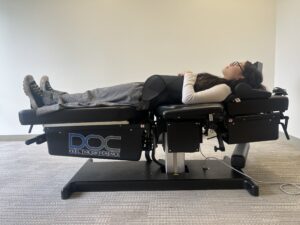Nerve pain in the shoulder blade can wreck your day or year if untreated. Moving the wrong way, even slightly, causes a burst of sharp pain. It wakes you up in the middle of the night. You may feel tired, agitated, and struggle to do everyday activities.
But would it surprise you to learn that shoulder nerve pain isn’t happening in the shoulder at all? Here’s what is really going on.
What Does Nerve Pain Feel Like?
Nerve pain is a distinct sensation most people recognize. They describe it as a sudden shooting, stabbing, stinging, or electrical shock in a targeted area.
Depending on the level of nerve damage, it may also feel like a more generalized burning feeling, numbness, or pins and needles. Based on where it is, it can certainly reduce your ability to move either because of pain or because the nerves can no longer communicate effectively.
You usually feel this shoulder nerve pain in the left shoulder blade or nerve pain in the right shoulder blade. Its exact position depends on which nerve is pinched.
More reading we think you’ll enjoy:
To get to the root cause of pain and discomfort, schedule an initial consultation, including a comprehensive nerve pain evaluation and first treatment.
What Causes Nerve Pain in the Shoulder?
Nerve pain near the shoulder blade occurs when a nerve is compressed in the neck. And curiously, you may not even have neck pain!
This is commonly called a “pinched nerve”. Nerves become pinched in the neck due to normal wear and tear, bone spurs, herniated disc (rupture), posture issues, and cervical spine misalignment related to these.
This nerve pain radiates from the nerve root in the neck (cervical spine) into the back shoulder blade. You may feel a pinch or sharp pain behind the shoulder blade or under the shoulder blade. Some people will feel nerve pain in the shoulder and arm.
Cervical Radiculopathy
A medical textbook would call this phenomenon “cervical radiculopathy”. “Cervical” as in the cervical spine (neck), and “radiculopathy” meaning roughly “a disorder that radiates”. This is a form of neuropathy (nerve damage).
Cervical Stenosis
Cervical stenosis (a type of spinal stenosis) is a related condition. It describes the narrowing of the path that runs down the middle of each neck bone. This path houses the spinal cord. Nerves shoot out from it to transport messages to other body parts.
Bulging or Herniated Disc
Discs are fluid-filled, tire-like cushions between each spinal bone that protect the auxiliary nerves from being squeezed when a neck has a natural alignment. Poor alignment causes them to bulge and even rupture, leaking fluid that irritates the nerve.
You may have one or all three of these conditions when you have nerve pain in the shoulder blade.
The doctor is pointing at a herniated disc on the image.

Nerve Pain Vs. Functional Shoulder Pain
Nerve pain in the back shoulder blade should be clearly distinguished from sharp or aching pain in the shoulder joint. That is more likely to be arthritis or a small tear, which requires a different treatment.
You can schedule an evaluation to uncover the true cause of your shoulder blade pain.
Is There a Nerve Under the Shoulder Blade?
“Axillary nerves” begin at the neck before moving down through the back of the shoulder blade and down the back of your upper arm. These nerves are responsible for sending messages to your arm so that it can move.
Can a Pinched Nerve Cause Severe Shoulder Pain?
Nerve pain in the shoulder blade area can cause excruciating pain and numbness. People who experience this pain over some time may also feel mentally and emotionally exhausted and irritable. They may struggle to function at work, at home, and in social situations.
Do I Have a Pinched Nerve in My Shoulder Blade?
Only an exam from a trained professional can definitively say if you have a pinched nerve. However, the pinched nerve is probably not in your shoulder. It’s in your neck. You’re experiencing radiating pain from the trapped nerve in your neck, which could lead you to believe the nerve irritation is happening in the shoulder.
No amount of shoulder rotations and shoulder massage will help because the issue is not actually behind your shoulder blade.
How to Fix Nerve Pain in Shoulder Blade at Home?
If nerve pain in the shoulder blade is mild and not recurring, then figuring out how to relieve nerve pain in the shoulder blade may be as easy as getting a different pillow. We always recommend you try these things at home first to see if it gets better:
- Make sure you’re getting enough sleep.
- Improve your neck posture.
- Set up your workstation ergonomically.
- Try over-the-counter painkillers for a short time while you work on these other fixes.
- (Note: Use as directed. These should not be taken long-term.)
- Perform a daily stretch routine or simple yoga poses.
- Hold positions for at least 6 seconds. No jerky movements.)
- Ask a family member for a gentle neck massage with hands only
- Switch pillows and avoid weird sleeping positions.
- Get recommended daily low-impact exercise, such as walking, cycling, or swimming.
- Alternate hot and cold packs.
- Address any vitamin deficiencies.
- B vitamins and the minerals magnesium and calcium, in particular, are critical to nerve health. Some other nutrients vital for the nervous system include Acetyl-l-carnitine, Alpha-lipoic acid, and glutamine.
If the pain persists for two weeks or keeps coming back, it’s time to see a chiropractor. Masking the pain will only provide temporary relief. The condition will get progressively worse.
How to Treat Nerve Pain in Shoulder Blade?
We perform a manual evaluation, imaging, and other tests to develop a science-based shoulder pain treatment plan using a functional medicine approach. That means we use therapeutic techniques that improve the mechanics of your body, relieving the pressure on the nerve. At the same time, you work with us to optimize the body’s natural healing ability.
With these tests, we can identify which nerve is being pinched. We then perform a spinal adjustment to relieve the pressure on that (and any) nerves. Over several chiropractic sessions, we work to retrain the cervical spine into its natural position and keep it there. Acupuncture, home exercises, and nutrition can all be important elements of the healing process.
If you’re also experiencing “functional shoulder pain” in the joint area, then Graston technique, acupuncture, or dry needling for shoulder pain might be recommended, as well.
To get started, schedule an evaluation and get your first treatment same day for nerve pain in your shoulder blade.
How Long Does Nerve Damage in the Shoulder Take to Heal?
Once the pressure is off the nerve, it takes 3-12 months for an auxiliary nerve to heal. During that time it’s important to keep the pressure off the nerve, so it doesn’t become re-injured.
After just one chiropractic session, most people will experience immediate shoulder nerve pain relief. After that, the goal of attending multiple chiropractic sessions is to ensure the spine stays aligned while the neck muscles and other connective tissues strengthen to support proper alignment.
You’re optimizing the body for proper healing.
Time to Experience Lasting Relief
Masking shoulder pain without treating the root cause will only allow the structure pinching the nerve to compress it further, causing significant and potentially irreparable damage. Proper diagnosis and treatment can help you get lasting relief from shoulder pain. Sticking with your treatment plan, including your home exercise plan, will allow you to maintain this relief. Let’s get started! schedule an evaluation and get your first treatment same day for nerve pain in your shoulder blade.
Read More: What Is a Chiropractic Adjustment?



